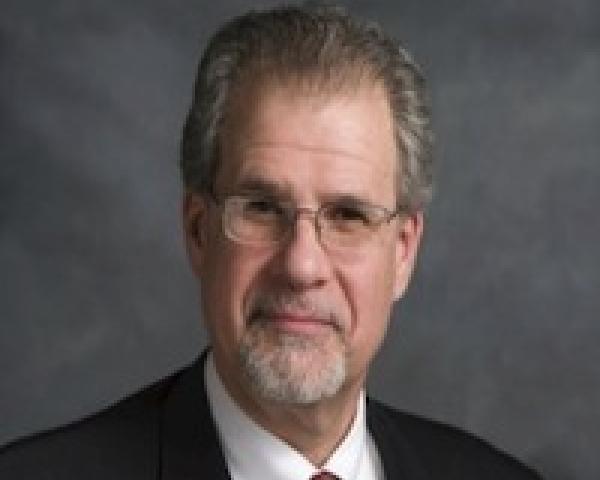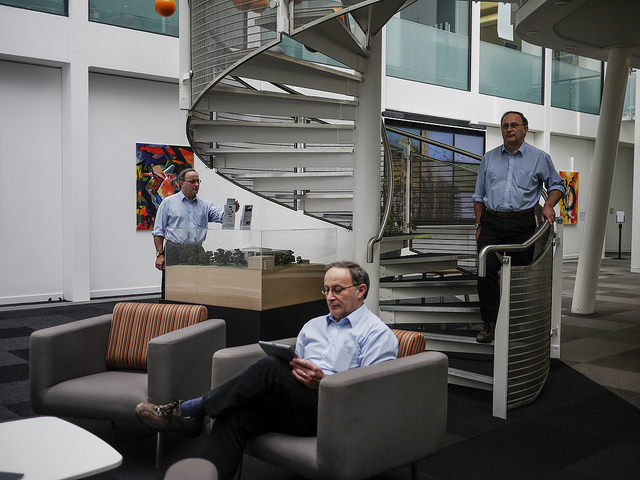What Millennials Demand as Customers
Millennials don't have the patience for traditional delays and stacks of documents. The industry faces a generation gap -- and it may be too late.

Millennials don't have the patience for traditional delays and stacks of documents. The industry faces a generation gap -- and it may be too late.

Get Involved
Our authors are what set Insurance Thought Leadership apart.
|
Partner with us
We’d love to talk to you about how we can improve your marketing ROI.
|

Alex Polyakov is CEO of Livegenic, which delivers real-time video solutions to help organizations reduce costs, improve customer satisfaction and mitigate risks. Polyakov has more than 15 years designing enterprise solutions in many industries, including IT, government, insurance, pharmaceuticals and talent management.
The recent free fall makes it feel as if we're entering a bear market, but stocks have actually been experiencing a correction for some time.

Get Involved
Our authors are what set Insurance Thought Leadership apart.
|
Partner with us
We’d love to talk to you about how we can improve your marketing ROI.
|

Brian Pretti is a partner and chief investment officer at Capital Planning Advisors. He has been an investment management professional for more than three decades. He served as senior vice president and chief investment officer for Mechanics Bank Wealth Management, where he was instrumental in growing assets under management from $150 million to more than $1.4 billion.
You're two weeks old, son. Let's start talking about leadership, about business, about people and about life.

 Live the vision, breathe the mission. Leadership can be defined as the ability to inspire others to achieve a shared objective. The two words that jump out for your dad are "inspire" and "shared." People will go the extra mile when inspired to do so. But remember, son, they must understand the bigger picture and their individual roles in the mission to be really inspired. Then live the mission, Bo. Live every single moment of every single day. Be passionate. Life is too short.
Live the vision, breathe the mission. Leadership can be defined as the ability to inspire others to achieve a shared objective. The two words that jump out for your dad are "inspire" and "shared." People will go the extra mile when inspired to do so. But remember, son, they must understand the bigger picture and their individual roles in the mission to be really inspired. Then live the mission, Bo. Live every single moment of every single day. Be passionate. Life is too short.
 Be open, honest and constructive. Feedback is a gift. As a leader, you will have the responsibility to provide feedback. Good and not so good. Both are equally important to the recipient. But, Bo, you must earn the right to give feedback to people. If you don't earn the respect of those around you, they won't listen to you, buddy. Always be respectful. People don't plan to mess up. They don't wake up in the morning and say to themselves: "Today I'm going to do everything I can to fail." When the time is right, and you'll know when, always be open, honest and constructive with feedback. Constructive, for me, is the most important word. Show peopl a path. Guide them down it.
Be open, honest and constructive. Feedback is a gift. As a leader, you will have the responsibility to provide feedback. Good and not so good. Both are equally important to the recipient. But, Bo, you must earn the right to give feedback to people. If you don't earn the respect of those around you, they won't listen to you, buddy. Always be respectful. People don't plan to mess up. They don't wake up in the morning and say to themselves: "Today I'm going to do everything I can to fail." When the time is right, and you'll know when, always be open, honest and constructive with feedback. Constructive, for me, is the most important word. Show peopl a path. Guide them down it.
 Make fast, high-quality, data-driven decisions. By the time you get the chance to lead people, the world will be moving way more quickly than it does today. And, son, it moves pretty damn quickly already. Don't ever make decisions based on a gut feeling. Even when you are under pressure to make a quick decision. We live in a world of big data. You may have a gut feeling about a topic or, as your dad calls it, a hypothesis (thanks, Mike Derezin). But prove your hypothesis with data before you pull the trigger on anything. Business or personal. Slow down to speed up.
Make fast, high-quality, data-driven decisions. By the time you get the chance to lead people, the world will be moving way more quickly than it does today. And, son, it moves pretty damn quickly already. Don't ever make decisions based on a gut feeling. Even when you are under pressure to make a quick decision. We live in a world of big data. You may have a gut feeling about a topic or, as your dad calls it, a hypothesis (thanks, Mike Derezin). But prove your hypothesis with data before you pull the trigger on anything. Business or personal. Slow down to speed up.
 Collaborate to win. The most successful people in the world are the ones who know how to collaborate. They are self-aware enough to know what they bring to the table. But they also take the time to understand the skills, ability, knowledge and experience of those around them. You will not succeed in life, Bo, if you try and go at it alone. And by the way, son, life is way more fun when you respect and work in partnership with those around you.
Collaborate to win. The most successful people in the world are the ones who know how to collaborate. They are self-aware enough to know what they bring to the table. But they also take the time to understand the skills, ability, knowledge and experience of those around them. You will not succeed in life, Bo, if you try and go at it alone. And by the way, son, life is way more fun when you respect and work in partnership with those around you.
 Keep things simple. Right now, you eat, sleep and poop. As you get older, you'll be pleased to know that you'll have the opportunity to do more things. You will engage with people. People are interesting, but they can bring complexity to life if you let them. As their leader, you will have the job of listening to the complexity, deconstructing their challenges, helping them simplify, helping them get to the core of an issue or a challenge and then sending them on their way. And, please, don't use 400 words when 10 well-chosen words will suffice. Keep things simple.
Keep things simple. Right now, you eat, sleep and poop. As you get older, you'll be pleased to know that you'll have the opportunity to do more things. You will engage with people. People are interesting, but they can bring complexity to life if you let them. As their leader, you will have the job of listening to the complexity, deconstructing their challenges, helping them simplify, helping them get to the core of an issue or a challenge and then sending them on their way. And, please, don't use 400 words when 10 well-chosen words will suffice. Keep things simple.
 Work hard, play hard. We all have to work, Bo. Life is expensive. But please pick something that makes you happy. Do something you are passionate about. Whatever you choose, remember to have fun. Don't take yourself too seriously. I don't, and it has served me well. Don't be afraid to laugh at yourself. You'll work hard. You're a Swift. But always strive for balance in your life. Work to live, don't live to work. Be present for those around you. There will be so many distractions. Life will get hectic if you let it. And, son, remember to breathe.
Work hard, play hard. We all have to work, Bo. Life is expensive. But please pick something that makes you happy. Do something you are passionate about. Whatever you choose, remember to have fun. Don't take yourself too seriously. I don't, and it has served me well. Don't be afraid to laugh at yourself. You'll work hard. You're a Swift. But always strive for balance in your life. Work to live, don't live to work. Be present for those around you. There will be so many distractions. Life will get hectic if you let it. And, son, remember to breathe.
 That's a wrap, Bo. Thanks for listening.
That's a wrap, Bo. Thanks for listening.
Get Involved
Our authors are what set Insurance Thought Leadership apart.
|
Partner with us
We’d love to talk to you about how we can improve your marketing ROI.
|

Dan Swift has worked in London, Sydney and now New York with highly talented people at high growth, innovative companies including GE Capital, Complinet, Thomson Reuters, LinkedIn and now Sprinklr. Swift has unique insight into how forward thinking senior executives can leverage social media to lead more effectively in a rapidly changing digital world. Swift is an advisory board member for Insurance Thought Leadership and CEO/Founder of Empire Social Media.
The relationships between clients and agents can now be facilitated by rating and matching services akin to Yelp and Angie's List.

Get Involved
Our authors are what set Insurance Thought Leadership apart.
|
Partner with us
We’d love to talk to you about how we can improve your marketing ROI.
|

Jonas Roeser is the co-founder and CEO of Agent Review, a website that brings the models made popular by Yelp and Angie’s List to insurance, empowering consumers to more easily navigate complex decisions about their life and health.
The bad news because of big data: If you have a profitable niche, everyone else will soon find it. The good news: You can still win.

Get Involved
Our authors are what set Insurance Thought Leadership apart.
|
Partner with us
We’d love to talk to you about how we can improve your marketing ROI.
|

Bret Shroyer is the solutions architect at Valen Analytics, a provider of proprietary data, analytics and predictive modeling to help all insurance carriers manage and drive underwriting profitability. Bret identifies practical solutions for client success, identifying opportunities to bring tangible benefits from technical modeling.
Few insurers found a killer app in the first Internet wave, but there is new hope. The formula for innovation: Think big, smart small, learn fast.

Remember the must-read book Unleashing the Killer App: Digital Strategies for Market Dominance, by Larry Downes and Chunka Mui? I was lucky to get a signed copy at a Diamond Technology Partners event and hear them speak about the killer app. It was in 1998, the start of the e-business revolution, with the emergence of the Internet as a platform for a new business model. Every company was holding executive management strategy sessions discussing the book and brainstorming. In the insurance industry, many were putting up their first websites and beginning to think about e-business opportunities that could become their killer apps.
Many insurance companies failed in this effort. Their vision wasn’t big enough. Their desire to upend existing models wasn’t strong enough. Rather, they thought incrementally and cautiously. This resulted in strange hybrid solutions, such as websites with no integration to back-end systems. Requests were printed off and manually put into the systems. Many companies wasted time on vaporware -- ideas that never got off the ground because of organizational angst or a lack of leadership.
The late 1990s were an exciting and painful time as we recalibrated our thinking toward an entirely new era of business. In spite of our efforts, we fell a lap or more behind in our race toward innovation.
But some companies succeeded. Think about Esurance and Homesite, startups that understood the opportunities and launched their businesses around this time. These companies exploited the dramatic changes introduced by the Internet and challenged one of the long-held business assumptions, that agents were required to sell and service insurance with direct-to-consumer models. As a result, they emerged as formidable, innovative companies.
Do established insurers have another chance to stay in the race?
Recently, I read the follow-up to the first book, this one titled, The New Killer Apps: How Large Companies Can Out-Innovate Start-ups, and another titled, Billion Dollar Lessons, both by Chunka Mui and Paul B. Carroll. Interestingly, the follow-up takes the view that decades- or century-long established companies can out-innovate today’s start-ups, many of whom are considered unicorns (pre-IPO tech start-ups with at least a $1 billion market value). These unicorns and other start-ups have emerged in the last few years with not only massive valuations but with real business models, real revenue and real customers -- unlike in the first Internet boom. Think of Uber, Airbnb, Snapchat, SpaceX and Pinterest.
Even more compelling for insurance is the rapidly growing intensity of change being influenced by these companies. Consider Uber and the impact on auto insurance, Airbnb and homeowners insurance or Snapchat’s new payment options.
The authors are quick to point out what we should all recognize, that being big AND agile is essential in today’s rapidly changing world of converging technology innovations, including mobile, social media, sensors, cameras, cloud and emergent knowledge. They estimate that more than $36 trillion of stock-market value is up for “re-imagination” in the near future — meaning that either existing companies reimagine their business and claim the markets of the future or the alternative may happen and they may be reimagined out of existence!
When the authors compared successes and failures of established companies, they found that successful companies thought big, started small and learned fast. Failures commonly missed on one or all of these points.
Is the insurance industry thinking big enough yet? Are companies innovating by starting small? And are they learning fast by experimenting, testing and learning from failures?
The only way insurers stand to catch up in a race where the trophy is not just success but also survival, is to out-innovate the competition, including the new competition from outside the industry looking to disrupt insurance. It’s possible, but it is going to require both wise technology investment and a whole new insurance business model mindset.
Get Involved
Our authors are what set Insurance Thought Leadership apart.
|
Partner with us
We’d love to talk to you about how we can improve your marketing ROI.
|

Denise Garth is senior vice president, strategic marketing, responsible for leading marketing, industry relations and innovation in support of Majesco's client-centric strategy.
Starbucks' director of risk management says: "Our job is to train others. . . to make good, sound risk management decisions."

 Steve Legg
His bio
Legg, who is 46 years old, has been at the Starbucks headquarters in Seattle since June 1997. His responsibilities include global corporate property and casualty insurance and risk financing for the company. Legg reports to the treasurer of Starbucks and heads a risk management team of 13 professionals, with two-thirds involved in claims management and the balance working in risk financing and risk transfer, its risk management information system (RMIS) , internal reporting and captive management. Starbucks has 22,519 stores in 66 countries, with a targeted growth rate of 1,650 net new stores during this fiscal year. Starbucks, the name inspired by Herman Melville’s novel Moby Dick, has one of the most recognized logos in the world. Its mission statement, developed by its founder Howard Schultz, is “to inspire and nurture the human spirit one person, one cup and one neighborhood at a time.”
Before joining Starbucks, Legg worked as an independent insurance broker, as well as in a claims capacity for Crawford & Co. Legg served on the board of the Washington state chapter of the Risk & Insurance Management Society (RIMS) for seven years, serving as president of the chapter during the 2005-2006 year. He has been an active participant within National RIMS and has served as a speaker to other insurance industry groups, such as the CPCU Society, the Professional Liability Underwriting Society (PLUS) and the Marine Insurance Association of Seattle. He has a degree in political economy of industrial societies from the University of California at Berkeley.
His story
Legg grew up in Kirkland, WA, on the east side of Lake Washington. Nicknamed “the little city that could,” Kirkland is the former headquarters for the Seattle Seahawks and Costco. Kirkland Signature is still Costco’s store brand.
“I grew up interested in a lot of different things, but I wouldn’t say with any degree of certainty that I knew what I wanted to do for a living,” Legg said. “I was intrigued with going somewhere else to study, so I attended UC Berkeley. I was interested in crisis management, and I just happened to be at Cal when the 6.9 Loma Prieta earthquake [1989] and devastating Oakland Hills firestorm [1991] hit. From those experiences, I thought I might pursue law school.
“As things turned out, my first job was back in Washington state working as a claims adjuster for the branch manager of Crawford & Co., hired by our mutual friend and industry colleague Katrina Zitnik, who was later director of workers’ comp for Costco, 2001-2013. We handled the huge Boeing workers’ comp self-insured account. There were around 100 employees in that office alone. My specialty was working with chemical-related claims, which was really fascinating, before I moved over to liability claims. By my second year there, I started to really understand what risk management was all about.”
From that experience, Legg went on to achieve his ARM designation. “It may sound corny, but I didn’t like the way it looked on my business card as Legg-ARM, so I went on to pursue my CPCU,” Legg said.
“With that formal insurance education, I went to work for a regional insurance brokerage in Kirkland where I learned a lot about insurance and other facets of risk management.” Legg said: “I came to this realization that I didn’t want to handle claims or broker insurance. I wanted to be on the buyer’s side of all this – tending to insurance and a whole lot of other things.”
In 1997, Legg was hired by his predecessor at Starbucks, which had gone public in 1992. At the time he joined Starbucks, the company had about 1,000 stores in the U.S. and Canada and just a few new locations in Japan. Legg describes his experience at that time in risk management as more of a buyer of insurance, but his job responsibilities quickly deepened and expanded with the global spread of Starbucks. He assumed the director of risk management position in 2006 when his boss and mentor retired and became active in the management of Starbucks’ Vermont captive.
The evolving company
Legg explained that the organizational structure is set up based on three key global regions: (1) the Americas; (2) EMEA, which is Europe, Middle East and Africa; and (3) CAP, which is China, Asia Pacific. “Our biggest push is in the CAP region, especially China, which presents a lot of opportunity,” he said. Although that region has a tea-drinking tradition, Legg pointed out that Starbucks owns the tea company Tazo and more recently bought Teavana and its 300-plus stores, providing a high-end, specialty tea product that has become popular at Starbucks locations. He said Starbucks’ specialty coffee and expresso beverages have also become very popular in tea-drinking cultures.
Starbucks has also expanded its offerings in premium pastries (it bought La Boulange), food and merchandise offerings, and it recently began providing beer and wine in selected areas of the country. “Evenings at Starbucks had been under-utilized,” Legg said, “so with the rollout of beer and wine we’re able to serve additional patrons.”
How Starbucks manages risk
Serving 66 countries with various laws and customs, Starbucks has a global quality assurance organization work with business units that are immersed in foreign locations. “Risk management and legal principles are practiced with our people that understand and are sensitive to local government, culture, customs and laws,” Legg said. “Starbucks wants to provide appropriate food and beverages, and we have a global safety security organization, as well, that makes sure that we are tending to the different types of risks these different and diverse cultures hold. Safety and security are fundamental components in the initial and on-going training of our partners."
When asked about the challenge of identifying, evaluating and treating risk in far-flung global operations, Legg noted that there is a common thread regardless of demographics that relates to keeping stores well-managed, clean, secure and hazard-free. He added that a global design team works with individual markets to address issues that mitigate any unusual risk factors, which could include something as simple as adjusting counter and stool height. Store components are designed to provide for each locale’s needs while Starbucks maintains the quality and consistency that its customers expect.
As for dealing with its insurance and reinsurance markets, Legg noted that Starbucks collects a significant amount of data on all of its locations to enable its internal team and underwriters to have the geographic information they need for modeling. North American operations are mostly self-insured via large retentions and deductibles; Legg points out that first-dollar and low-deductible insurance policies are far more common, accessible and prevalent in other parts of the world. Compulsory insurance requirements differ across jurisdictions -- in many parts of the world, for instance, workers’ compensation as we know it is not available, and injuries or illnesses among employees (which Starbucks calls "partners") are addressed in different ways.
“Regardless of the transfer or retention of risk, Starbucks feels that no one could ever care as much about our partners and our brand as we do,” Legg said. He added, “We inspire and nurture our partners and customers… through providing good products, friendly service and by contributing to our communities. It’s an important part of our culture and what makes this brand so strong.”
All eligible full- and part-time Starbucks employees receive comprehensive health coverage and equity in their company, referred to as “bean stock.” In turn, employees typically volunteer more than one million hours each year in helping their local communities. Starbucks has also set up agronomy offices in different countries around the world to help origin farmers to better manage their crops and businesses. “It’s really important all up and down the chain from the front-line stores to the source of the company’s most precious commodity to have a seamless connection,” Legg said.
His suggestions
I asked Legg what coaching suggestions he has for people entering the field of risk management.
He said, “I think to be successful in risk management that it helps to have a good understanding of a number of different disciplines like accounting, finance, law, etc. Most importantly, you need to have the ability to think critically through things to make good decisions and to then have the ability to communicate well and to influence others. Knowledge without good communication skills won’t equip you for this career.
“I find myself guiding and teaching other people in the organization every day, helping them develop their own risk assessment philosophy in what they do day in and day out. We in risk management can’t be there all the time, so our job is to train others throughout the organization to make good, sound risk management decisions.
“Be open-minded and flexible. Risk management staff needs to identify and admit their mistakes, correct things and be able to change course as needed.”
Legg added with a laugh, “You think you know in detail how things are, then you find out you really don’t know how things are.”
Steve Legg
His bio
Legg, who is 46 years old, has been at the Starbucks headquarters in Seattle since June 1997. His responsibilities include global corporate property and casualty insurance and risk financing for the company. Legg reports to the treasurer of Starbucks and heads a risk management team of 13 professionals, with two-thirds involved in claims management and the balance working in risk financing and risk transfer, its risk management information system (RMIS) , internal reporting and captive management. Starbucks has 22,519 stores in 66 countries, with a targeted growth rate of 1,650 net new stores during this fiscal year. Starbucks, the name inspired by Herman Melville’s novel Moby Dick, has one of the most recognized logos in the world. Its mission statement, developed by its founder Howard Schultz, is “to inspire and nurture the human spirit one person, one cup and one neighborhood at a time.”
Before joining Starbucks, Legg worked as an independent insurance broker, as well as in a claims capacity for Crawford & Co. Legg served on the board of the Washington state chapter of the Risk & Insurance Management Society (RIMS) for seven years, serving as president of the chapter during the 2005-2006 year. He has been an active participant within National RIMS and has served as a speaker to other insurance industry groups, such as the CPCU Society, the Professional Liability Underwriting Society (PLUS) and the Marine Insurance Association of Seattle. He has a degree in political economy of industrial societies from the University of California at Berkeley.
His story
Legg grew up in Kirkland, WA, on the east side of Lake Washington. Nicknamed “the little city that could,” Kirkland is the former headquarters for the Seattle Seahawks and Costco. Kirkland Signature is still Costco’s store brand.
“I grew up interested in a lot of different things, but I wouldn’t say with any degree of certainty that I knew what I wanted to do for a living,” Legg said. “I was intrigued with going somewhere else to study, so I attended UC Berkeley. I was interested in crisis management, and I just happened to be at Cal when the 6.9 Loma Prieta earthquake [1989] and devastating Oakland Hills firestorm [1991] hit. From those experiences, I thought I might pursue law school.
“As things turned out, my first job was back in Washington state working as a claims adjuster for the branch manager of Crawford & Co., hired by our mutual friend and industry colleague Katrina Zitnik, who was later director of workers’ comp for Costco, 2001-2013. We handled the huge Boeing workers’ comp self-insured account. There were around 100 employees in that office alone. My specialty was working with chemical-related claims, which was really fascinating, before I moved over to liability claims. By my second year there, I started to really understand what risk management was all about.”
From that experience, Legg went on to achieve his ARM designation. “It may sound corny, but I didn’t like the way it looked on my business card as Legg-ARM, so I went on to pursue my CPCU,” Legg said.
“With that formal insurance education, I went to work for a regional insurance brokerage in Kirkland where I learned a lot about insurance and other facets of risk management.” Legg said: “I came to this realization that I didn’t want to handle claims or broker insurance. I wanted to be on the buyer’s side of all this – tending to insurance and a whole lot of other things.”
In 1997, Legg was hired by his predecessor at Starbucks, which had gone public in 1992. At the time he joined Starbucks, the company had about 1,000 stores in the U.S. and Canada and just a few new locations in Japan. Legg describes his experience at that time in risk management as more of a buyer of insurance, but his job responsibilities quickly deepened and expanded with the global spread of Starbucks. He assumed the director of risk management position in 2006 when his boss and mentor retired and became active in the management of Starbucks’ Vermont captive.
The evolving company
Legg explained that the organizational structure is set up based on three key global regions: (1) the Americas; (2) EMEA, which is Europe, Middle East and Africa; and (3) CAP, which is China, Asia Pacific. “Our biggest push is in the CAP region, especially China, which presents a lot of opportunity,” he said. Although that region has a tea-drinking tradition, Legg pointed out that Starbucks owns the tea company Tazo and more recently bought Teavana and its 300-plus stores, providing a high-end, specialty tea product that has become popular at Starbucks locations. He said Starbucks’ specialty coffee and expresso beverages have also become very popular in tea-drinking cultures.
Starbucks has also expanded its offerings in premium pastries (it bought La Boulange), food and merchandise offerings, and it recently began providing beer and wine in selected areas of the country. “Evenings at Starbucks had been under-utilized,” Legg said, “so with the rollout of beer and wine we’re able to serve additional patrons.”
How Starbucks manages risk
Serving 66 countries with various laws and customs, Starbucks has a global quality assurance organization work with business units that are immersed in foreign locations. “Risk management and legal principles are practiced with our people that understand and are sensitive to local government, culture, customs and laws,” Legg said. “Starbucks wants to provide appropriate food and beverages, and we have a global safety security organization, as well, that makes sure that we are tending to the different types of risks these different and diverse cultures hold. Safety and security are fundamental components in the initial and on-going training of our partners."
When asked about the challenge of identifying, evaluating and treating risk in far-flung global operations, Legg noted that there is a common thread regardless of demographics that relates to keeping stores well-managed, clean, secure and hazard-free. He added that a global design team works with individual markets to address issues that mitigate any unusual risk factors, which could include something as simple as adjusting counter and stool height. Store components are designed to provide for each locale’s needs while Starbucks maintains the quality and consistency that its customers expect.
As for dealing with its insurance and reinsurance markets, Legg noted that Starbucks collects a significant amount of data on all of its locations to enable its internal team and underwriters to have the geographic information they need for modeling. North American operations are mostly self-insured via large retentions and deductibles; Legg points out that first-dollar and low-deductible insurance policies are far more common, accessible and prevalent in other parts of the world. Compulsory insurance requirements differ across jurisdictions -- in many parts of the world, for instance, workers’ compensation as we know it is not available, and injuries or illnesses among employees (which Starbucks calls "partners") are addressed in different ways.
“Regardless of the transfer or retention of risk, Starbucks feels that no one could ever care as much about our partners and our brand as we do,” Legg said. He added, “We inspire and nurture our partners and customers… through providing good products, friendly service and by contributing to our communities. It’s an important part of our culture and what makes this brand so strong.”
All eligible full- and part-time Starbucks employees receive comprehensive health coverage and equity in their company, referred to as “bean stock.” In turn, employees typically volunteer more than one million hours each year in helping their local communities. Starbucks has also set up agronomy offices in different countries around the world to help origin farmers to better manage their crops and businesses. “It’s really important all up and down the chain from the front-line stores to the source of the company’s most precious commodity to have a seamless connection,” Legg said.
His suggestions
I asked Legg what coaching suggestions he has for people entering the field of risk management.
He said, “I think to be successful in risk management that it helps to have a good understanding of a number of different disciplines like accounting, finance, law, etc. Most importantly, you need to have the ability to think critically through things to make good decisions and to then have the ability to communicate well and to influence others. Knowledge without good communication skills won’t equip you for this career.
“I find myself guiding and teaching other people in the organization every day, helping them develop their own risk assessment philosophy in what they do day in and day out. We in risk management can’t be there all the time, so our job is to train others throughout the organization to make good, sound risk management decisions.
“Be open-minded and flexible. Risk management staff needs to identify and admit their mistakes, correct things and be able to change course as needed.”
Legg added with a laugh, “You think you know in detail how things are, then you find out you really don’t know how things are.”
Get Involved
Our authors are what set Insurance Thought Leadership apart.
|
Partner with us
We’d love to talk to you about how we can improve your marketing ROI.
|

As a renown workers’ compensation expert and industry thought leader for 40 years, Jeff Pettegrew seeks to promote and improve understanding of the advantages of the unique Texas alternative injury benefit plan through active engagement with industry and news media as well as social media.
Superstores like Walmart and Costco show how insurers can create the convenient, one-stop-shopping experiences that consumers want.

Get Involved
Our authors are what set Insurance Thought Leadership apart.
|
Partner with us
We’d love to talk to you about how we can improve your marketing ROI.
|

Tim Attia is the CEO of Slice Labs; a technology company addressing challenges facing the on-demand economy. Prior to Slice, he worked with some of the largest global insurance carriers on technology and distribution. He started his career with a large technology and management consulting firm.
...but now is always the time. Businesses of all sizes need to have a strategy about what to do -- and what to not do -- to allocate resources well.

Get Involved
Our authors are what set Insurance Thought Leadership apart.
|
Partner with us
We’d love to talk to you about how we can improve your marketing ROI.
|

Amy Radin is a transformation strategist, a scholar-practitioner at Columbia University and an executive adviser.
She partners with senior executives to navigate complex organizational transformations, bringing fresh perspectives shaped by decades of experience across regulated industries and emerging technology landscapes. As a strategic adviser, keynote speaker and workshop facilitator, she helps leaders translate ambitious visions into tangible results that align with evolving stakeholder expectations.
At Columbia University's School of Professional Studies, Radin serves as a scholar-practitioner, where she designed and teaches strategic advocacy in the MS Technology Management program. This role exemplifies her commitment to bridging academic insights with practical business applications, particularly crucial as organizations navigate the complexities of Industry 5.0.
Her approach challenges traditional change management paradigms, introducing frameworks that embrace the realities of today's business environment – from AI and advanced analytics to shifting workforce dynamics. Her methodology, refined through extensive corporate leadership experience, enables executives to build the capabilities needed to drive sustainable transformation in highly regulated environments.
As a member of the Fast Company Executive Board and author of the award-winning book, "The Change Maker's Playbook: How to Seek, Seed and Scale Innovation in Any Company," Radin regularly shares insights that help leaders reimagine their approach to organizational change. Her thought leadership draws from both her scholarly work and hands-on experience implementing transformative initiatives in complex business environments.
Previously, she held senior roles at American Express, served as chief digital officer and one of the corporate world’s first chief innovation officers at Citi and was chief marketing officer at AXA (now Equitable) in the U.S.
Radin holds degrees from Wesleyan University and the Wharton School.
To explore collaboration opportunities or learn more about her work, visit her website or connect with her on LinkedIn.
We will see more mergers, to strengthen offerings, broaden footprints, position for growth and ultimately seize the pot of gold in insurance.

Get Involved
Our authors are what set Insurance Thought Leadership apart.
|
Partner with us
We’d love to talk to you about how we can improve your marketing ROI.
|

Deb Smallwood, the founder of Strategy Meets Action, is highly respected throughout the insurance industry for strategic thinking, thought-provoking research and advisory skills. Insurers and solution providers turn to Smallwood for insight and guidance on business and IT linkage, IT strategy, IT architecture and e-business.